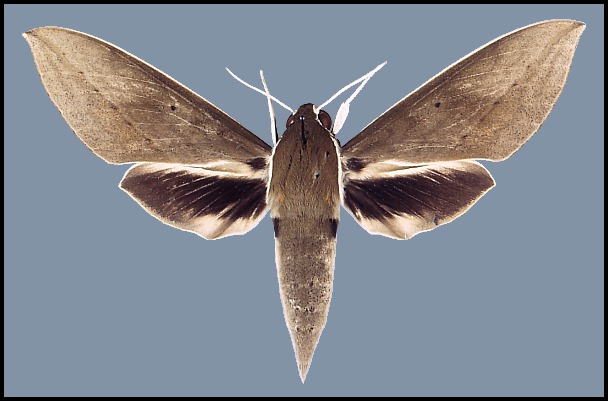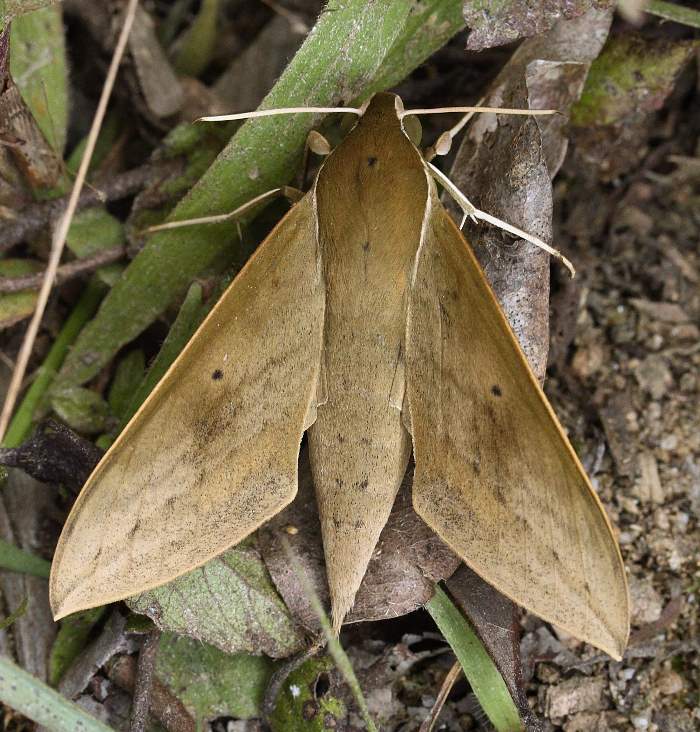Type species: Sphinx equestris Fabricius, 1793 (=S. nessus Drury, 1773).
A genus consisting of about 30 species occurring in the Oriental and Australasian regions, with some penetrating into the southern Palaearctic and Afrotropical regions.
IMAGO: Labial palpus smoothly scaled; first segment with an apical cavity on outer side bounded by this scaling, with the joint visible in it. On the inside, the apical scaling on segment 1 is regular as in Hippotion, but unlike other genera, segment 2 bears at its apex a tuft of inwardly directed scales. Antenna in both sexes rod-like, long, with terminal segment short. Hindtibia with two pairs of spurs, the inner spurs longer than the outer. Very closely allied to Hippotion. As in that genus, wings and abdomen elongate.
Genitalia. In male, uncus rather narrow, underside weakly concave apically. Gnathos obtusely pointed, apex curved upwards, strongly convex beneath. Valva with numerous friction scales; sacculus slender, S-shaped, pointed. Phallus with a short multidentate process on right side, and a long oblique row of teeth on a raised ridge on the left. In the female, the ridge before the ostium bursae rather thin, but well chitinized and smooth, forming a half-moon shape.
OVUM: Broadly ovoid, smooth, shiny green or whitish.
LARVA: Like that of Hippotion. Head small and rounded, with body tapering forward from swollen, ocellate abdominal segments 1 and 2. Rest of body cylindrical. Horn erect, short or of medium length. Always with a pale dorso-lateral line in which there may be numerous eye-spots.
PUPA: Very similar to that of Hippotion. Proboscis fused with body, but projecting forward, laterally compressed and carinate. A coxal piece always present. Ante-spiracular ridges almost always present. Cremaster long, pointed, without apical spines.
HOSTPLANT FAMILIES: Usually herbaceous plants and vines of the Vitaceae, Araceae, Onagraceae, Lythraceae, Rubiaceae and Dilleniaceae.
UK: Boisduvals' Hawkmoth
Sphinx boisduvalii Bugnion, 1839, Annls Soc. ent. Fr. 1839: 115.Type locality: Ile de Candie [Crete].
(Taxonomic note. Cechenena sumatrensis Joicey & Kaye, 1917, Ann. Mag. nat. Hist. (8) 20: 307, previously included within Theretra boisduvalii, is now regarded as being a good species, namely Theretra sumatrensis (Joicey & Kaye, 1917).)
[Further details on this species, as well as photos of all stages, can be found on Lepiforum.]
Palaeotropical; Oriental region.

Wingspan: 85--110mm. Immediately distinguished from Theretra alecto (Linnaeus, 1758) by its dark brown forewing and blackish hindwing; not very variable.

Frequents edges of woodland and cultivated areas where species of Vitaceae grow.
Very little is known about the behaviour of this species except that it is strongly attracted to light and flowers.
Most likely during late summer as a migrant to the region.
OVUM: Large (2mm), oval, pale glossy green.
LARVA: Very like that of Theretra alecto.
Hostplants. Vitis and Parthenocissus spp.
PUPA: 53--70mm. Very similar to that of Theretra alecto. Does not overwinter in the region.
None recorded.
A rare migrant to south-eastern Iran, and thence possibly westwards as a very rare vagrant to Turkey and Greece. No individuals have been recorded from Europe in recent years. As Theretra boisduvalii and Theretra alecto have both shared the name cretica, it may be that many 'records' of this species from Europe are due to misunderstanding.
Extra-limital range. From south-eastern Iran eastwards to Sri Lanka, the Himalayan foothills (to 400m), and across South East Asia to Borneo.
 Return to species list
Return to species list